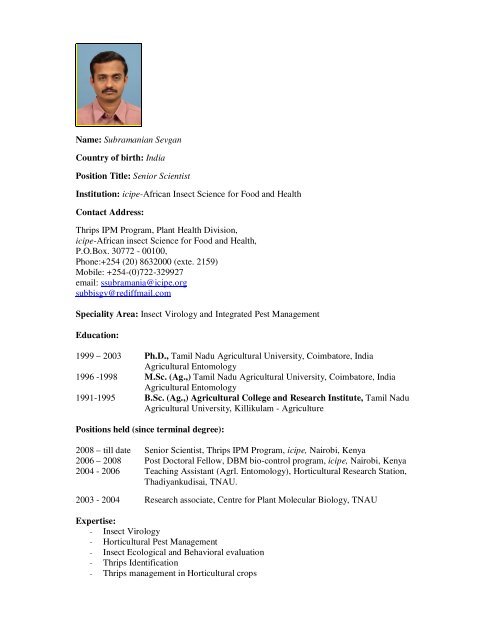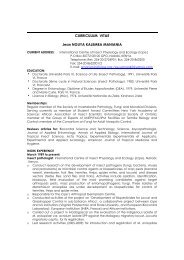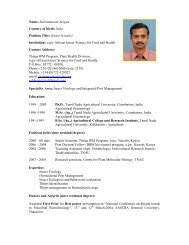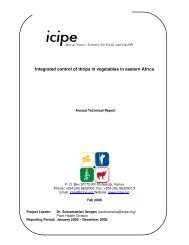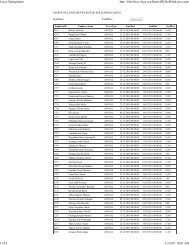Name: Subramanian Sevgan Country of birth: India Position ... - icipe
Name: Subramanian Sevgan Country of birth: India Position ... - icipe
Name: Subramanian Sevgan Country of birth: India Position ... - icipe
Create successful ePaper yourself
Turn your PDF publications into a flip-book with our unique Google optimized e-Paper software.
<strong>Name</strong>: <strong>Subramanian</strong> <strong>Sevgan</strong><br />
<strong>Country</strong> <strong>of</strong> <strong>birth</strong>: <strong>India</strong><br />
<strong>Position</strong> Title: Senior Scientist<br />
Institution: <strong>icipe</strong>-African Insect Science for Food and Health<br />
Contact Address:<br />
Thrips IPM Program, Plant Health Division,<br />
<strong>icipe</strong>-African insect Science for Food and Health,<br />
P.O.Box. 30772 - 00100,<br />
Phone:+254 (20) 8632000 (exte. 2159)<br />
Mobile: +254-(0)722-329927<br />
email: ssubramania@<strong>icipe</strong>.org<br />
subbisgv@rediffmail.com<br />
Speciality Area: Insect Virology and Integrated Pest Management<br />
Education:<br />
1999 – 2003 Ph.D., Tamil Nadu Agricultural University, Coimbatore, <strong>India</strong><br />
Agricultural Entomology<br />
1996 -1998 M.Sc. (Ag.,) Tamil Nadu Agricultural University, Coimbatore, <strong>India</strong><br />
Agricultural Entomology<br />
1991-1995 B.Sc. (Ag.,) Agricultural College and Research Institute, Tamil Nadu<br />
Agricultural University, Killikulam - Agriculture<br />
<strong>Position</strong>s held (since terminal degree):<br />
2008 – till date Senior Scientist, Thrips IPM Program, <strong>icipe</strong>, Nairobi, Kenya<br />
2006 – 2008 Post Doctoral Fellow, DBM bio-control program, <strong>icipe</strong>, Nairobi, Kenya<br />
2004 - 2006 Teaching Assistant (Agrl. Entomology), Horticultural Research Station,<br />
Thadiyankudisai, TNAU.<br />
2003 - 2004 Research associate, Centre for Plant Molecular Biology, TNAU<br />
Expertise:<br />
- Insect Virology<br />
- Horticultural Pest Management<br />
- Insect Ecological and Behavioral evaluation<br />
- Thrips Identification<br />
- Thrips management in Horticultural crops
Honors and Awards (since terminal degree):<br />
Awarded First Prize for Best poster presentation in “National Conference on Recent trends<br />
in Microbial Biotechnology”, 11 th and 12 th March-2004, SASTRA Deemed University,<br />
Thanjavur<br />
Major research accomplishments:<br />
First report <strong>of</strong> spiracular mode <strong>of</strong> infection by Helicoverpa armigera nucleopolyhedrovirus.<br />
(Jeyarani, S, Rabindra, R. J., Sathiah, N., Karuppachamy, P and S. <strong>Subramanian</strong>.<br />
2007. Journal <strong>of</strong> Virological Methods 142: 213 – 217).<br />
Showed how incubation temperature can influence the productivity and quality <strong>of</strong> Spodoptera<br />
litura nucleopolyhedrovirus. (S. <strong>Subramanian</strong>, G. Santharam, N. Sathiah, J. S.<br />
Kennedy and R.J. Rabindra, 2006 Biological Control 37: 367 – 374)<br />
Illustrated Impact <strong>of</strong> granulovirus infection on susceptibility <strong>of</strong> Spodoptera litura to<br />
insecticides. (S. <strong>Subramanian</strong>, R.J. Rabindra, S. Palaniswamy, N. Sathiah and B.<br />
Rajasekaran. 2005. Biological Control 33: 165 – 172)<br />
Selection <strong>of</strong> refereed journal publications (2002-present)<br />
S. <strong>Subramanian</strong>, R.J. Rabindra and N. Sathiah, 2009. Economic threshold for the<br />
management <strong>of</strong> Plutella xylostella with granulovirus in cauliflower ecosystem.<br />
Phytoparasitica, DOI 10.1007/s12600-009-0066-z<br />
S. <strong>Subramanian</strong> and B. Löhr, 2008. Is Diamondback Moth a polyphagous pest? Some<br />
thoughts about its host range expansion to pea. In: Proc. <strong>of</strong> 5 th International workshop on<br />
The management <strong>of</strong> Diamondback moth and other crucifer pests. A.M. Shelton¸<br />
H.L.Collins, Z.Youjun and W. U. Qingjun (eds.). pp. 63 – 71, Oct, 24 th – 27th , Beijing,<br />
China Agricultural Science and Technology Press, China.<br />
S. <strong>Subramanian</strong>, R. J. Rabindra, and S. Sithanantham, 2008. Genetic and biological<br />
variations among Plutella xylostella granulovirus isolates. Phytoparasitica 36: 220-230.<br />
Jeyarani, S, Rabindra, R. J., Sathiah, N., Karuppachamy, P and S. <strong>Subramanian</strong>. 2007.<br />
Evaluation <strong>of</strong> spiracle mode <strong>of</strong> infection for Helicoverpa armigera nucleopolyhedrovirus<br />
mass production. Journal <strong>of</strong> Virological Methods 142: 213 – 217.<br />
S. <strong>Subramanian</strong>, G. Santharam, N. Sathiah, J. S. Kennedy and R.J. Rabindra, 2006.<br />
Influence <strong>of</strong> incubation temperature on productivity and quality <strong>of</strong> Spodoptera litura<br />
nucleopolyhedrovirus. Biological Control 37: 367 – 374.<br />
S. <strong>Subramanian</strong> and S. Mohankumar. 2006. Genetic variability <strong>of</strong> the bollworm,<br />
Helicoverpa armigera, occurring on different host plants. 8pp. Journal <strong>of</strong> Insect Science<br />
6: 26, available online: insectscience.org/6.26.<br />
S. <strong>Subramanian</strong>, R.J. Rabindra, S. Palaniswamy, N. Sathiah and B. Rajasekaran. 2005.<br />
Impact <strong>of</strong> granulovirus infection on susceptibility <strong>of</strong> Spodoptera litura to insecticides.<br />
Biological Control 33: 165 – 172.<br />
S. <strong>Subramanian</strong>, R. Parthasarathy, R.J. Rabindra, N. Sathiah and S. Rajagopal babu. 2005.<br />
The infectivity <strong>of</strong> the entomopathogenic nematode, Steinernema glaseri against the<br />
moringa hairy caterpillar, Eupterote mollifera. Nematologia mediterranea. 33: 151 – 156.
R. Sriram, P. A. Saravanan, M. Muthuraman, S. Mohankumar and S. <strong>Subramanian</strong>. 2004.<br />
Genetic Diversity Analysis <strong>of</strong> Stingless Bees in <strong>India</strong>. In: Proc. <strong>of</strong> 8 th IBRA International<br />
Conference on Tropical Bees and VI Encontro sobre Abelhas. K. H. Hartfelder, D. D.<br />
Jong, R. A. Pereira, A. D. S. Cristino, M. M. Morais, E. D. Tanaka, A. P. Lourenco, J. E.<br />
B. da Silva, G. F. De Almeida and A. M do Nascimento (eds.).pp. 366 – 370. Sep. 6 – 10,<br />
Ribeiro Perto, Sao Paulo, Brazil<br />
S. GeethaRajalakshmi, S. <strong>Subramanian</strong>, S. Mohankumar and P. S. Shanmugasundaram.<br />
2006. Molecular analysis <strong>of</strong> Leucinodes orbonalis populations within Tamil Nadu using<br />
lepidopteran specific random markers. Pest Management in Horticultural Ecosystems 12:<br />
29 – 36.<br />
S. GeethaRajalakshmi, S. <strong>Subramanian</strong>, S. Jaigeetha and S. Mohankumar. 2005. A novel<br />
method <strong>of</strong> rearing the fruit and shoot borer, Leucinodes orbonalis Guen. Insect<br />
Environment 10: 179 – 180.<br />
Parthasarathy, R., S. RajagopalBabu, S. <strong>Subramanian</strong>, R. J. Rabindra and B. Rajasekaran.<br />
2004. Comparative toxicity <strong>of</strong> certain insecticides to the moringa hairy caterpillar,<br />
Eupterote mollifera (Walker) and its economics. Pest management in Horticultural<br />
Ecosystems, 10, 173 – 178.<br />
Rabindra, R.J., M. Swamiappan, R. Parthasarathy, S. <strong>Subramanian</strong>, J.S. Kennedy, N.<br />
Sathiah and B. Rajsekaran. 2003. Isolation and characterisation <strong>of</strong> nuclear polyhedrosis<br />
Virus from the looper Boarmia (=Ascotis) selenaria (Lepidoptera: Geometridae) Pest<br />
Management in Horticultural Ecosystems 9: 49 – 53.<br />
RajagopalBabu, S., R. Parthasarathy, S. <strong>Subramanian</strong>, R. J. Rabindra and J. S. Kennedy.<br />
2002. Susceptibility <strong>of</strong> the moringa hairy caterpillar, Eupterote mollifera walker<br />
(Lepidoptera: Eupterotidae) to certain formulations <strong>of</strong> Bacillus thuringienseis In:<br />
Biological control <strong>of</strong> Lepidopteran Pests. Tandon, P. L., Ballal, C. R., Jalali, S. K. and R.<br />
J. Rabindra (eds.) Society for Biocontrol Advancement, Bangalore, pp. 177-179.<br />
Book chapters:<br />
S. <strong>Subramanian</strong>, G. Santharam, J. S. Kennedy, N. Sathiah and R. J. Rabindra. 2007.<br />
Glycerol-based aqueous formulation <strong>of</strong> Nucleopolyhedrovirus in the management <strong>of</strong><br />
Spodoptera litura. In: S. Ignacimuthu, sj, and S. Jayaraj (Eds.) Biotechnology and Insect<br />
Pest Management , Narosa Publishing House, New Delhi. Pp. 107 - 116.<br />
S. Mohankumar, T. Ramasubramanian and S. <strong>Subramanian</strong>, 2007. Intra-population<br />
variation among the Helicoverpa armigera population identified using Simple sequence<br />
repeat markers. In: S. Ignacimuthu, sj, and S. Jayaraj (Eds.) Biotechnology and Insect<br />
Pest Management , Narosa Publishing House, New Delhi. Pp. 226 – 230.<br />
S. <strong>Subramanian</strong>, S. Geetha, G. Santharam and R.J. Rabindra, 2006. Diversity analysis <strong>of</strong><br />
Spodoptera litura nuclear polyhedrosis virus isolates In: S. Ignacimuthu, sj, and S.<br />
Jayaraj (Eds.) Biodiversity and Insect Pest Management , Narosa Publishing House, New<br />
Delhi. Pp. 216 – 223.<br />
Sunil Martin, S. <strong>Subramanian</strong>, Amit Kumar Mishra and S. Mohankumar. 2006. Diversity <strong>of</strong><br />
Solanum spp. in relation to resistance to Eggplant shoot and fruit borer, Leucinodes<br />
orbonalis Guenee”. In: S. Ignacimuthu, sj, and S. Jayaraj (Eds.) Biodiversity and Insect<br />
Pest Management Narosa Publishing House, New Delhi. 201 – 209.
S. <strong>Subramanian</strong>, R.J. Rabindra, S. Palaniswamy and N. Sathiah. 2005. Susceptibility <strong>of</strong><br />
different instars <strong>of</strong> Spodoptera litura (F.) to its granulosis virus and vertical transmission<br />
<strong>of</strong> virus. In: S. Ignacimuthu, sj, and S. Jayaraj (Eds.) Green Pesticides for Insect Pest<br />
Management. Narosa Publishing House, New Delhi, pp. 165 – 172.<br />
S. Mohankumar, A. Selvi, M. Asaithambi, S. <strong>Subramanian</strong>, V. Thiruvengadam and P.<br />
Shanmugasundaram. 2005. Marker-assisted selection as a strategy for selecting insect<br />
resistant breeding lines with improved efficiency. In: S. Ignacimuthu, sj, and S. Jayaraj<br />
(Eds.) Green Pesticides for Insect Pest Management. Narosa Publishing House, New<br />
Delhi, pp. 241 - 250.<br />
N. Sathiah, R. J. Rabindra, S. Palaniswamy, K. P. Jayant, S <strong>Subramanian</strong>, C. M. Senthil<br />
Kumar, B. Rajasekaran and J.S.Kennedy. 2005 Microbial Control <strong>of</strong> Helicoverpa<br />
armigera. In: R. J. Rabindra., S.S. Hussaini and B. Ramanujam (Eds.) Microbial<br />
biopesticides formulation and application. Tech. Doc. No. 55, Project Directorate <strong>of</strong><br />
Biological Control, Bangalore -560 024. pp. 49-89.<br />
Mohankumar, S and S. <strong>Subramanian</strong>. 2004. Biotechnological Approaches for Integrated pest<br />
Management in vegetable crops. Proceedings <strong>of</strong> the Asian Regional IPM CRSP<br />
Workshop, June 29 – 30, 2004, Manila, Phillipines. pp 71 - 97 Available Online at<br />
http://www.oired.vt.edu/ipmcrsp/meetings/consolidated%20na%20talaga.pdf.<br />
Invited presentations at major international conferences (2002-present – Maximum 8)<br />
2009 – “IX International Symposium on Thysanoptera and Tospoviruses, 31 st August – 4 th<br />
September, 2009, Sea World, Queensland, Australia. Paper: Altitudinal differences in<br />
abundance and diversity <strong>of</strong> thrips on tomatoes (Lycopersicon esculentum Mill.) in East<br />
Africa<br />
2008 - “XXIII International Congress <strong>of</strong> Entomology”, 6 th – 12 th July, 2008, International<br />
convention centre, Durban. Papers: Economic threshold for the management <strong>of</strong><br />
Plutella xylostella with granulovirus in cauliflower<br />
2006 - “The 5 th International Workshop on management <strong>of</strong> the diamondback moth and<br />
other crucifer pest” 24 th – 27 th October, 2006. Beijing, China. Papers: Is<br />
diamondback moth a polyphagous pest? Some thoughts about its host range<br />
expansion to pea<br />
Research Grants (2004 – present):<br />
Funding source Grant Title (Principal investigators) Amount<br />
US$<br />
BMZ<br />
Integrated control <strong>of</strong> thrips in vegetables<br />
in eastern Africa (<strong>Subramanian</strong> <strong>Sevgan</strong>)<br />
Period<br />
1.3million June 2008 –<br />
till date


